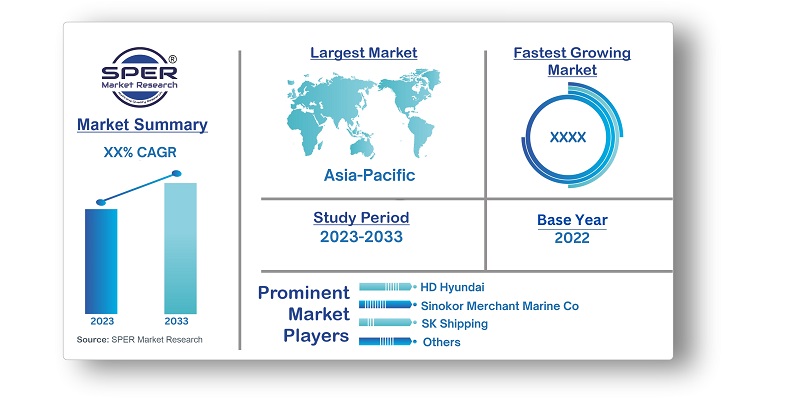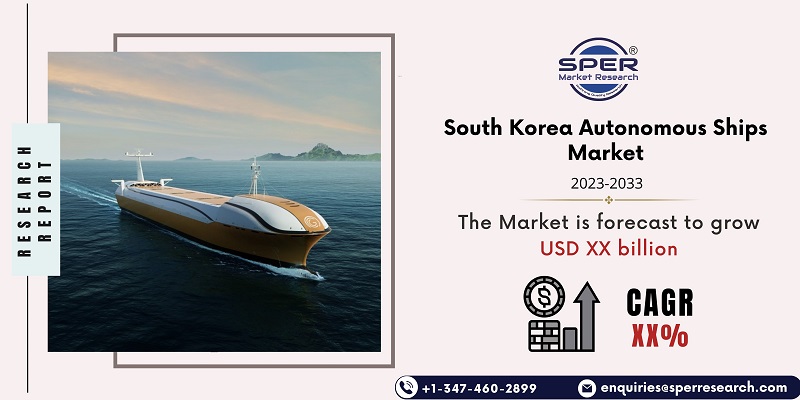
South Korea Autonomous Ships Market Growth, Size, Trends, Demand, Revenue and Future Outlook
South Korea Autonomous Ships Market Size– By Autonomy, By Ship Type- Regional Outlook, Competitive Strategies and Segment Forecast to 2033
| Published: Feb-2024 | Report ID: AMIN2448 | Pages: 1 - 105 | Formats*: |
| Category : Automotive & Transportation | |||
- March 2023: A joint development project agreement (JDA) has been signed by Samsung Heavy Industries Co. (SHI) and Kongsberg Maritime (KM) to construct a next-generation autonomous 174K LNG carrier that makes use of low-emission technologies and autonomous remote control.
- December 2020: Hyundai Heavy Industries formed the subsidiary Avikus. In June 2021, the company tested an autonomous cruise boat that can accommodate 12 passengers, and the following year, it will be on sale.


| Report Metric | Details |
| Market size available for years | 2019-2033 |
| Base year considered | 2022 |
| Forecast period | 2023-2033 |
| Segments covered | By Autonomy, By Ship Type |
| Regions covered | Busan, Ulsan, Incheon and Seoul |
| Companies Covered | HD Hyundai, Sinokor Merchant Marine Co., SK Shipping, Samsung Heavy Industries, Kongsberg Maritime, Wärtsilä, Rolls-Royce Holdings plc. And various others. |
- Maritime and Shipping Companies
- Shipbuilding Manufacturers
- Government and Regulatory Bodies
- Research and Development Institutions
- Sea Logistics
- Port Authorities
- Defence and Military Organizations
- Investors and Financial Institutions
- International Maritime Organizations
| By Autonomy: |
|
| By Ship Type: |
|
| By Region: |
|
- South Korea Autonomous Ships Market Size (FY’2023-FY’2033)
- Overview of South Korea Autonomous Ships Market
- Segmentation of South Korea Autonomous Ships Market By Autonomy (Fully Autonomous, Remotely Operated, Partially Autonomous)
- Segmentation of South Korea Autonomous Ships Market By Ship Type (Military, Commercial)
- Statistical Snap of South Korea Autonomous Ships Market
- Expansion Analysis of South Korea Autonomous Ships Market
- Problems and Obstacles in South Korea Autonomous Ships Market
- Competitive Landscape in the South Korea Autonomous Ships Market
- Impact of COVID-19 and Demonetization on South Korea Autonomous Ships Market
- Details on Current Investment in South Korea Autonomous Ships Market
- Competitive Analysis of South Korea Autonomous Ships Market
- Prominent Players in the South Korea Autonomous Ships Market
- SWOT Analysis of South Korea Autonomous Ships Market
1.1. Scope of the report1.2. Market segment analysis
2.1. Research data source2.1.1. Secondary Data2.1.2. Primary Data2.1.3. SPER’s internal database2.1.4. Premium insight from KOL’s2.2. Market size estimation2.2.1. Top-down and Bottom-up approach2.3. Data triangulation
4.1. Driver, Restraint, Opportunity and Challenges analysis4.1.1. Drivers4.1.2. Restraints4.1.3. Opportunities4.1.4. Challenges4.2. COVID-19 Impacts of the South Korea Autonomous Ships Market
5.1. SWOT Analysis5.1.1. Strengths5.1.2. Weaknesses5.1.3. Opportunities5.1.4. Threats5.2. PESTEL Analysis5.2.1. Political Landscape5.2.2. Economic Landscape5.2.3. Social Landscape5.2.4. Technological Landscape5.2.5. Environmental Landscape5.2.6. Legal Landscape5.3. PORTER’s Five Forces5.3.1. Bargaining power of suppliers5.3.2. Bargaining power of buyers5.3.3. Threat of Substitute5.3.4. Threat of new entrant5.3.5. Competitive rivalry5.4. Heat Map Analysis
6.1. South Korea Autonomous Ships Market Manufacturing Base Distribution, Sales Area, Type, Application6.2. Mergers & Acquisitions, Partnerships, Type Launch, and Collaboration in South Korea Autonomous Ships Market
7.1. South Korea Autonomous Ships Market Value Share and Forecast, By Autonomy, 2023-20337.2. Fully Autonomous7.3. Partially Autonomous7.4. Remotely Operated
8.1. South Korea Autonomous Ships Market Value Share and Forecast, By Ship Type, 2023-20338.2. Commercial8.3. Military
9.1. South Korea Autonomous Ships Market Size and Market Share
10.1. South Korea Autonomous Ships Market Size and Market Share By Autonomy (2019-2026)10.2. South Korea Autonomous Ships Market Size and Market Share By Autonomy (2027-2033)
11.1. South Korea Autonomous Ships Market Size and Market Share By Ship Type (2019-2026)11.2. South Korea Autonomous Ships Market Size and Market Share By Ship Type (2027-2033)
12.1. South Korea Autonomous Ships Market Size and Market Share By Region (2019-2026)12.2. South Korea Autonomous Ships Market Size and Market Share By Region (2027-2033)12.2.1. Busan12.2.2. Incheon12.2.3. Seoul12.2.4. Ulsan
13.1. HD Hyundai13.1.1. Company details13.1.2. Financial outlook13.1.3. Type summary13.1.4. Recent developments13.2. Kongsberg Maritime13.2.1. Company details13.2.2. Financial outlook13.2.3. Type summary13.2.4. Recent developments13.3. SK Shipping13.3.1. Company details13.3.2. Financial outlook13.3.3. Type summary13.3.4. Recent developments13.4. Samsung Heavy Industries13.4.1. Company details13.4.2. Financial outlook13.4.3. Type summary13.4.4. Recent developments13.5. Sinokor Merchant Marine Co.13.5.1. Company details13.5.2. Financial outlook13.5.3. Type summary13.5.4. Recent developments13.6. Wärtsilä13.6.1. Company details13.6.2. Financial outlook13.6.3. Type summary13.6.4. Recent developments13.7. Others
SPER Market Research’s methodology uses great emphasis on primary research to ensure that the market intelligence insights are up to date, reliable and accurate. Primary interviews are done with players involved in each phase of a supply chain to analyze the market forecasting. The secondary research method is used to help you fully understand how the future markets and the spending patterns look likes.
The report is based on in-depth qualitative and quantitative analysis of the Product Market. The quantitative analysis involves the application of various projection and sampling techniques. The qualitative analysis involves primary interviews, surveys, and vendor briefings. The data gathered as a result of these processes are validated through experts opinion. Our research methodology entails an ideal mixture of primary and secondary initiatives.



Frequently Asked Questions About This Report
PLACE AN ORDER
Year End Discount
Sample Report
Pre-Purchase Inquiry
NEED CUSTOMIZATION?
Request CustomizationCALL OR EMAIL US
100% Secure Payment






Related Reports
Our Global Clients
Our data-driven insights have influenced the strategy of 200+ reputed companies across the globe.




















